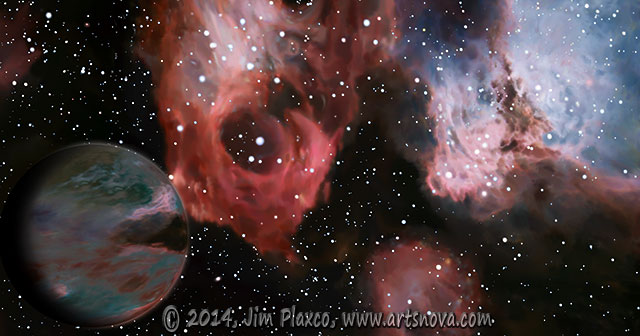Exoplanet in the Large Magellanic Cloud
It has been quite some time since I've created a work of astronomical art. Strike that. It's been some time since I've finished a work of astronomical art. In fact I've not done a very good job of adding such art to my web site. No I didn't make a new year's resolution to do more astronomical art. I'm not sure what possessed me to take a break from my other projects and create this piece of art. Last year I had started work on an exoplanet project. I had painted a number of exoplanets and for a while was quite devoted to it. One of the things I did was to create a database of both the exoplanets and their stars. I previously wrote about this initial foray in The Small Stars of Exoplanets.
My plan was to use both my art and an analysis of the data I'd collected to create a presentation on exoplanets. This would be an addition to my current lineup of lectures, talks, and presentations (I should point out that I do space exploration and astronomy presentations in my role as President of the Chicago Society for Space Studies and as a NASA JPL Solar System Ambassador).
Artistic Inspiration
The artwork consists of three main components: the exoplanet, the nebula, and the stars. While the exoplanet was drawn solely from my imagination, the nebula was inspired by NGC 2035. In fact, the specific image that I used as a reference is The star formation region NGC 2035 imaged by the ESO Very Large Telescope. This image is described as:
The Large Magellanic Cloud is one of the closest galaxies to our own. Astronomers have now used the power of the ESO's Very Large Telescope to explore NGC 2035, one of its lesser known regions, in great detail. This new image shows clouds of gas and dust where hot new stars are being born and are sculpting their surroundings into odd shapes. But the image also shows the effects of stellar death – filaments created by a supernova explosion.
Artistic Process
I created this art using only Adobe Photoshop CS4 and my Wacom tablet. I used a variety of custom brushes I had previously created specifically for painting astronomical art.
My first step was to paint the neublar structure. I did this using a variety of brushes. One feature that greatly increased the flexibility I had was to take advantage of Photoshop's brush mode option. The mode option makes it possible for your new brush strokes to interact with previous brush strokes in different ways. This is a very useful technique that is most probably greatly underused as I don't think I've ever seen it mentioned in any astronomical art tutorials for Photoshop.
Having completed the nebula, my next step was to create the starfield. I did this on a separate Photoshop layer. Separating the stars from the nebula allows me to work on the two independently. It's worth pointing out that this is a fictional starfield. For the starfield the main question I had to answer was sharp or soft: did I want stars with sharp edges or soft edges. I opted for soft edges because the first stars I painted were those in front of the nebula.
I created my exoplanet in a separate Photoshop document. I did this for several reasons. First and most important I wanted to create the planet on a scale much larger than the size it would have in the final composition. Second, because the planet involved a number of layers, I wanted to keep them together as a separate document. This path facilitates my ability to reuse all or part of this exoplanet for other projects.
Once I was satisfied with my exoplanet, I copied the planet as a single layer back to my original Photoshop document. I now resized and positioned the exoplanet. Fortunately I knew exactly where I wanted to place the planet and used that knowledge in creating my exoplanet. To better tie the exoplanet to the nebula, I arranged for the cloud structure to continue the nebula's pattern as can be seen by observing the 3:00 position of the exoplanet's limb. Okay – that might be a little difficult to observe since the original painting is 20 x 15 inches and what is shown here, if printed, would only be 2 x 1 inches.
Exoplanet in the Large Magellanic Cloud Digital Painting
To see the uncropped version, as well as some small full-size sections, see Exoplanet in the Large Magellanic Cloud Digital Painting. I've added this artwork to my Space Art Gallery as well as to my Astronomical Art Gallery. As is my custom, I've limited the number of limited edition prints for this piece to five.
| Return to the Blog Index | This entry was posted on Monday, January 20th, 2014 at 10:34 am and is filed under Astronomical Art, Digital Art, Photoshop.
